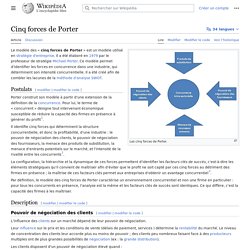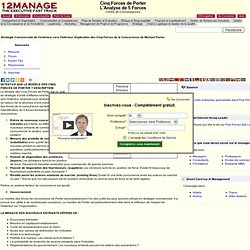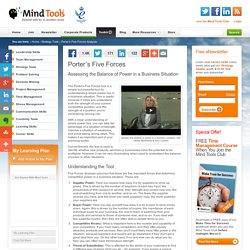

Michael Porter. Un article de Wikipédia, l'encyclopédie libre.

Michael Porter au World Economic Forum de Davos. Michael Porter, né le 23 mai 1947 à Ann Arbor dans le Michigan, est professeur de stratégie d'entreprise à l'Université Harvard et consultant d'entreprise. Introduction[modifier | modifier le code] Michael Porter a ensuite participé à la fondation du cabinet de conseil en stratégie Monitor Group, dont il est encore un des vice-présidents. Le modèle des cinq forces[modifier | modifier le code] Les cinq forces de Porter L'un des principaux apports théoriques de Porter consiste en une modélisation de l'environnement concurrentiel de l'entreprise sous la forme de cinq facteurs, dits forces de Porter, qui influent sur le partage des profits au sein d'une industrie : l'intensité de la rivalité entre les concurrents ;le pouvoir de négociation des clients ;le pouvoir de négociation des fournisseurs ;la menace d'entrants potentiels sur le marché ;la menace des produits de substitution ; Années 1970 Années 1980.
Cinq forces de Porter. Les cinq forces de Porter.

Wikipédia a besoin de vous Chers lecteurs du Canada, vous utilisez souvent Wikipédia, c'est formidable ! C’est un peu gênant, mais ce mercredi, nous avons besoin de vous. Si vous avez déjà fait un don, nous vous en remercions sincèrement. Nous ne sommes pas des vendeurs, nous dépendons de dons de $15 en moyenne, mais moins de 2% de nos lecteurs contribuent. Merci ! Le modèle des « cinq forces de Porter » a été élaboré en 1979 par le professeur de stratégie Michael Porter. Selon Porter, cinq forces déterminent la structure concurrentielle d'une industrie de biens ou de services : le pouvoir de négociation des clients,le pouvoir de négociation des fournisseurs,la menace des produits de substitution,la menace d'entrants potentiels sur le marché,l'intensité de la rivalité entre les concurrents.
Description[modifier | modifier le code] Pouvoir de négociation des clients[modifier | modifier le code] Les clients disposent d'un pouvoir de négociation élevé quand : Porter's Five Forces: Summary, Forum and Expert Tips. What is the Five Forces model of Porter?

Description The Five Forces model of Porter is an Outside-in business unit strategy tool that is used to make an analysis of the attractiveness (value) of an industry structure. The Competitive Forces analysis is made by the identification of 5 fundamental competitive forces: Entry of competitors. How easy or difficult is it for new entrants to start competing, which barriers do exist.
Sometimes a sixth competitive force is added: Government. Cinq Forces de Porter. Qu'est-ce que le Modèle des Cinq Forces de Porter ?

Description Le Modèle des Cinq Forces de Porter est un outil de stratégie d'unité d'affaires orienté de l'extérieur vers l'intérieur, employé pour analyser l'attractivité (la valeur) de la structure d'une industrie. L'analyse des forces de la concurrence est faite par l'identification de 5 forces fondamentales de concurrence : Entrée de nouveaux concurrents. (new entrants) est-il facile ou difficile pour de nouveaux entrants de commencer à concurrencer le secteur, quelles barrières existent. Parfois un sixième facteur de concurrence est ajouté : Porter's five forces analysis - Notes. Porter's Five Forces - Problem Solving Techniques from MindTools. Assessing the Balance of Power in a Business Situation Assess the balance of power in a business situation, with James Manktelow & Amy Carlson.

The Porter's Five Forces tool is a simple but powerful tool for understanding where power lies in a business situation. This is useful, because it helps you understand both the strength of your current competitive position, and the strength of a position you're considering moving into. With a clear understanding of where power lies, you can take fair advantage of a situation of strength, improve a situation of weakness, and avoid taking wrong steps. This makes it an important part of your planning toolkit. Conventionally, the tool is used to identify whether new products, services or businesses have the potential to be profitable.
Understanding the Tool Five Forces Analysis assumes that there are five important forces that determine competitive power in a business situation. From "How Competitive Forces Shape Strategy" by Michael E. Porter's Five Forces Video - Strategy Skills from MindTools. Assess the balance of power in a business situation, with James Manktelow & Amy Carlson.

James Manktelow: Hello, I'm James Manktelow, CEO of MindTools.com, home to hundreds of free, career-boosting tools and resources. Amy Carlson: And I'm Amy Carlson from Mind Tools. In business, your ability to make a good profit depends on how strong your position is in the market. For instance, do you have any competitors offering similar products? Is it easy for people to enter your market if they see that you're making a profit? Can customers bully you into lowering your prices?
If we don't think about our position in the market carefully, we can easily find that we're working very hard, yet still struggling to stay afloat.